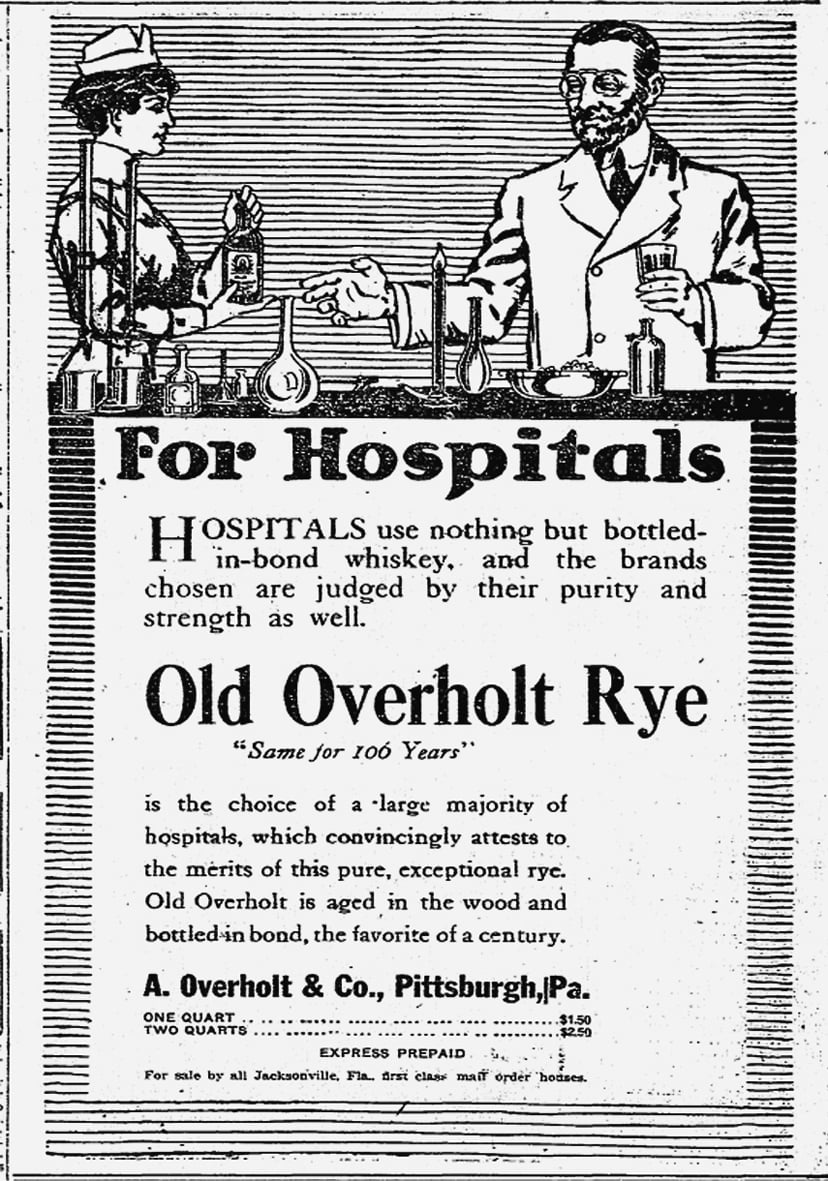Old Overholt is a brand of American rye whisky with a long legacy, but that legacy isn’t particularly consistent: although it is the oldest continually maintained brand of American whisky, like many legacy rye and bourbon brands it has passed through the hands of several owners, who have produced it to differing standards at different facilities over the years. It is named after Abraham Overholt (1784–1870), a Pennsylvania weaver and farmer who, around 1810, began distilling spirits full-time at his family’s West Overton, Pennsylvania, farm. By the Civil War, he had built a new, modern distillery at nearby Broad Ford, a short rail journey to the commercial hub of Pittsburgh. As was common for the time, the spirits were sold more as a bulk commodity than as a brand. Nonetheless, Overholt’s whisky was of sufficient quality to have been mentioned by name in advertisements since the 1840s (it appeared frequently in Baltimore newspapers then as “Overholt & Sons’ Monongahela Rye Whiskey”).
The brand name Old Overholt started appearing regularly during the 1870s, shortly after Abraham passed away, found slumped over in his privy. His obituary in the Washington Reporter claimed he had amassed wealth “almost equal in extent and value to the Kingdom of many a German Prince.” His grandson Henry Clay Frick (1849–1919) used the fortune to begin his career in the steel industry. In 1881, when Frick was already a rich man, he bought the Overholt company, selling a third of it to his banker, Andrew W. Mellon (1855–1937), and a third to Charles W. Mauk (1864–1938), who ran the business. Mauk, an energetic young man, proved to be a more than able manager and with the help of master distiller Jacob “Daddy” Meyers built the brand into the nation’s leading name in rye whisky.
After Frick’s death the company went to Mellon, who was then secretary of the treasury and was forced to sell it—this was during Prohibition—to the conglomerate later known as National Distillers. National Distillers, who promoted the brand heavily after Repeal, produced the brand at the Overholt distillery until 1952, when in the face of declining public interest in rye it closed the facility. After that, production was shuttled between a few other Pennsylvania distilleries before settling at the Forks of Elkhorn Distillery near Frankfort, Kentucky. By that point, in the 1970s, it was the last nationally distributed brand of rye whisky left; once exclusively sold as a bonded whisky, it was reduced to 40 percent abv and sold at bottom-shelf prices. After Jim Beam Brands purchased the brand in 1987, that distillery was shuttered too and production was moved to Beam’s large distillery at Clermont, Kentucky, where it is currently made using the same recipe as Jim Beam Rye.
In 2018, Beam-Suntory took a step toward restoring this historic whisky’s fortunes by releasing a bonded version for the first time since the 1960s.
See also whisky, rye; and Jim Beam.
Advertisements. Baltimore American and Commercial Daily Advertiser, November 3, 1845; January 15, 1846; and October 23, 1846.
Cowdery, Charles K. Bourbon Strange: Surprising Stories of American Whiskey. Chicago: Made and Bottled in Kentucky, 2014.
Harvey, George, Henry Clay Frick: The Man. New York: Charles Scribner’s Sons, 1928.
“J. H. White Promoted.” Connelsville (PA) Weekly Courier, December 22, 1904.
“Neighborhood news.” Washington (PA) Reporter, January 26, 1870, 5.
“Park & Tilford Buy Overholt Distillery.” New York Times, May 26, 1925.
Washington Review and Examiner, September 11, 1872, 3.
Wondrich, David, “The Rise and Fall of America’s Oldest Whiskey.” Daily Beast, September 26, 2016. https://www.thedailybeast.com/the-rise-and-fall-of-americas-oldest-whiskey (accessed March 5, 2021).
By: Reid Mitenbuler
1917 advertisement for Old Overholt rye whisky. With Prohibition looming, American distillers were clutching at straws, the medical virtues of whisky among them.
Wondrich Collection.
 1917 advertisement for Old Overholt rye whisky. With Prohibition looming, American distillers were clutching at straws, the medical virtues of whisky among them. Source: Wondrich Collection.
1917 advertisement for Old Overholt rye whisky. With Prohibition looming, American distillers were clutching at straws, the medical virtues of whisky among them. Source: Wondrich Collection.
